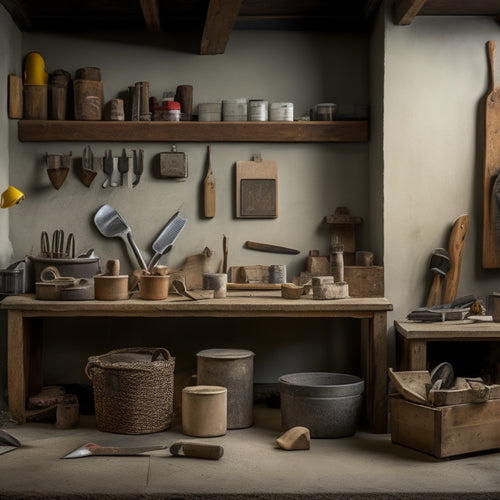
5 Best Mixing Paddle Options for Home Renovations
Share
When tackling home renovation projects, you need a mixing paddle that balances durability, ergonomics, and size to work efficiently. You'll want to take into account paddles made from stainless steel, high-impact nylon, or polypropylene, each suited for specific tasks and materials. Look for ergonomic handles with contoured shapes, textured grips, or cushioned coatings to reduce fatigue and improve control. Paddle size is also essential, as longer paddles are ideal for large volumes, and larger blades are needed for heavy materials. By understanding these factors, you'll be able to select the right mixing paddle for your project, and exploring further will help you find the perfect fit.
Key Takeaways
• For heavy-duty mixing tasks, consider stainless steel paddles for exceptional durability and corrosion resistance.
• Ergonomic handle options like contoured shapes, textured grips, and cushioned coatings enhance comfort and reduce fatigue during extended use.
• Choose paddle sizes tailored to specific tasks, such as longer paddles for large volumes and shorter paddles for paint or adhesives.
• Budget-friendly options in durable materials like stainless steel or fiberglass can still deliver professional results with unique blade designs and ergonomic features.
• Research top-rated brands, read user reviews, and compare features to identify the best value options that cater to specific home renovation needs.
Mixing Paddle Materials Matter
When selecting a mixing paddle for your home renovation project, you'll find that the material it's made of considerably impacts its performance, durability, and overall value.
You need a paddle that can withstand the rigors of mixing heavy materials like concrete or mortar. Stainless steel mixing paddles are a popular choice for their exceptional durability and resistance to corrosion. They're ideal for heavy-duty applications and can handle high-speed mixing without compromising their structural integrity.
On the other hand, if you're looking for a mixing paddle that offers versatility, consider one made from high-impact nylon or polypropylene. These materials provide excellent flexibility and can withstand the rigors of mixing a variety of materials, from thinset to epoxy. They're also lightweight and easy to maneuver, making them perfect for smaller projects or when working in tight spaces.
Regardless of the material you choose, guarantee it's built to last and can deliver the performance you need to get the job done efficiently. By selecting the right mixing paddle material, you'll be able to tackle your home renovation project with confidence and precision.
Ergonomic Handle Options
You'll find that an ergonomic handle can make all the difference in reducing fatigue and improving control during extended mixing sessions. A well-designed handle can help you maintain a secure grip, even when your hands are sweaty or wearing gloves.
Look for handles with a contoured shape that fits comfortably in your hand, allowing you to apply even pressure without straining your wrist or forearm. Handle comfort is essential, as it directly affects your ability to control the paddle.
Opt for handles with a textured grip to prevent slipping, and consider those with cushioning or rubberized coatings for added comfort. The grip texture should provide a secure hold without being too rough or abrasive.
Some ergonomic handles also feature adjustable or rotating grips, which can help reduce strain on your wrist and forearm. By choosing a mixing paddle with an ergonomic handle, you'll be able to work more efficiently and effectively, even during demanding renovation projects.
Paddle Size for Various Tasks
Selecting the right paddle size for your mixing task can greatly impact the efficiency and quality of your work, as different paddle sizes are better suited for specific tasks and materials.
When choosing a paddle, you'll want to take into account paddle length considerations. For example, a longer paddle is ideal for mixing large volumes of material, such as concrete or mortar, as it allows for more efficient mixing and reduces fatigue. On the other hand, a shorter paddle is better suited for smaller mixing tasks, like mixing paint or adhesives.
You'll also need to take into account your mixing volume requirements. If you're working with large quantities of material, you'll need a paddle that can handle the volume. Look for paddles with a larger blade surface area to guarantee effective mixing. Conversely, if you're working with smaller quantities, a paddle with a smaller blade surface area will suffice.
Budget-Friendly Mixing Paddles
Within a tight budget, finding a reliable mixing paddle can be a challenge, but there are affordable options available that won't compromise on performance. As a DIY enthusiast, you don't have to break the bank to get a decent mixing paddle for your home renovation projects.
Look for budget-friendly options made from durable materials like stainless steel or fiberglass that can withstand heavy mixing.
When it comes to mixing techniques, a budget-friendly paddle can still deliver professional results. For instance, you can use a paddle with a unique blade design to efficiently mix thick materials like concrete or mortar.
Some budget-friendly paddles also come with ergonomic handles that reduce fatigue, allowing you to work for extended periods without straining your hands or wrists.
For DIY projects that require heavy mixing, consider a paddle with a high-torque design that can handle thick materials with ease.
With a budget-friendly mixing paddle, you can achieve professional results without overspending. By choosing the right paddle for your specific needs, you can focus on perfecting your mixing techniques and completing your DIY projects efficiently.
Top-Rated Mixing Paddle Brands
When researching mixing paddle options, identifying top-rated brands that consistently deliver high-quality products is essential for ensuring your DIY projects meet professional standards. You'll want to look for brands that have built a reputation for producing durable, efficient, and reliable mixing paddles.
To narrow down your search, start by reading user reviews and comparing brand features. Look for brands that offer a range of paddle sizes, materials, and handle types to suit your specific needs.
Some top-rated brands to evaluate include DeWalt, Milwaukee, and Makita, which are known for their high-torque motors and ergonomic design.
Brand comparisons can also help you identify the best value for your money. For example, you may find that a particular brand offers a more affordable option with similar features to a higher-end brand.
By doing your research and assessing user reviews, you can make an informed decision and choose a mixing paddle that meets your project demands.
Frequently Asked Questions
Can I Use a Mixing Paddle With a Cordless Drill?
You're wondering if you can use a mixing paddle with a cordless drill. The answer is yes, but it depends on the mixing paddle type and drill compatibility.
Look for paddles specifically designed for drill use, with a 1/4' or 1/2' hex shaft.
Verify your cordless drill has enough torque and speed to handle the paddle's demands.
Check the paddle's RPM rating and match it to your drill's capabilities for efficient mixing.
How Do I Clean a Mixing Paddle After Use?
Imagine scrubbing a caked-on frying pan - that's what cleaning a mixing paddle can feel like if you don't do it right.
You'll want to use gentle cleaning techniques to avoid damaging the paddle materials. For most paddles, a soft-bristled brush and mild soap will do the trick.
For tougher messes, try soaking the paddle in warm water before scrubbing.
Dry thoroughly to prevent rust or corrosion.
Are Mixing Paddles Suitable for Mixing Hot Materials?
When working with hot materials, you'll want to guarantee your mixing paddle can handle the heat.
Look for paddles with heat resistance, typically made from materials like stainless steel or silicone.
Check the manufacturer's specs for material compatibility with high-temperature materials.
If you're mixing hot cement, for instance, a paddle with a heat-resistant coating is a must.
Don't risk damaging your paddle or compromising your mix - choose a paddle that can withstand the heat.
Can I Use a Mixing Paddle for Mixing Small Quantities?
When you're working with small quantities, you're likely wondering if a mixing paddle is still a viable option. The answer is yes, but it depends on the paddle size.
For small batch mixing, you'll want to opt for a smaller mixing paddle that can effectively reach the bottom of your mixing container.
Look for paddles with adjustable handles or compact designs to guarantee efficient mixing in tight spaces.
Are Mixing Paddles Dishwasher Safe?
You're wondering if you can toss that mixing paddle in the dishwasher, aren't you?
Coincidentally, many mixing paddles are designed with convenience in mind. Most modern mixing paddles, regardless of size, are made from dishwasher-safe materials like stainless steel, silicone, or nylon.
However, it's crucial to check the manufacturer's instructions, as some larger mixing paddle sizes or those with electronic components might require hand washing.
Conclusion
You've made it to the finish line!
After sifting through the sea of mixing paddles, you're now equipped to tackle even the most challenging home renovation projects.
With the right paddle in hand, you'll be mixing like a pro in no time, whipping up batches of compound like they're going out of style.
Remember, a good mixing paddle is the unsung hero of your toolkit - don't settle for anything less than the best!
Related Posts
-

Crack Repair Inspection Checklist for Home Renovation
When creating a crack repair inspection checklist for your home renovation project, you'll want to identify crack typ...
-

3 Beginner-Friendly Tools for Plaster Renovation Success
You'll be glad to know that the three essential tools you need for a successful plaster renovation are the same ones ...
-

7 Best Tool Storage Ideas for Home Renovation
When it comes to home renovation, staying organized is key to maximizing productivity and minimizing wasted time. To ...


